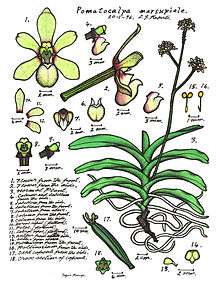Pomatocalpa marsupiale
Pomatocalpa marsupiale, commonly known as the branched bladder orchid,[2] is an epiphytic or lithophytic orchid that forms large clumps. It has many thick roots, branched stems, many strap-like, leathery leaves and up to many upward-facing green flowers with a cream-coloured or yellowish labellum. It usually grows on high on rainforest trees and is found between Sulawesi and tropical North Queensland, Australia.
| Branched bladder orchid | |
|---|---|
 | |
| Illustration by Lewis Roberts | |
| Scientific classification | |
| Kingdom: | Plantae |
| Clade: | Tracheophytes |
| Clade: | Angiosperms |
| Clade: | Monocots |
| Order: | Asparagales |
| Family: | Orchidaceae |
| Subfamily: | Epidendroideae |
| Genus: | Pomatocalpa |
| Species: | P. marsupiale |
| Binomial name | |
| Pomatocalpa marsupiale | |
| Synonyms[1] | |
Description
Pomatocalpa marsupiale is an epiphytic or lithophytic herb forming large clumps with a branched main stem, 200–500 millimetres (7.9–20 in) long and thick roots. There are many leathery, channelled yellowish green leaves, 150–300 mm (5.9–12 in) long and 40–50 mm (1.6–2.0 in) wide with their bases obscuring the stem.
Between fifteen and twenty green flowers, 12–15 mm (0.47–0.59 in) long and wide are borne on each branch of a flowering stem 200–450 mm (7.9–18 in) long. The sepals and petals spread widely apart from each other. The sepals are 6–8 mm (0.24–0.31 in) long, about 3 mm (0.12 in) wide and the petals are 5–6 mm (0.20–0.24 in) long and about 2 mm (0.079 in) wide. The labellum is cream-coloured or yellowish, 4–5 mm (0.16–0.20 in) long, 3–4 mm (0.12–0.16 in) wide with three lobes. The side lobes curve forwards and the middle lobe is short, thick and fleshy with a pear-shaped spur about 4 mm (0.16 in) long. Flowering occurs from November to May.[2][3][4][5]
The branched bladder orchid is differentiated from the other Australian Pomatocalpa species, P. macphersonii (blotched bladder orchid), by its taller, upright stems, larger leaves, crowded flowers, flower color, and bloom time.[5]
Taxonomy and naming
The branched bladder orchid was first formally described in 1889 by Friedrich Kraenzlin as Cleisostoma marsupiale. He published the description in Die Flora von Kaiser Wilhelms Land.[6] In 1912 Johannes Jacobus Smith changed the name to Pomatocalpa marsupiale.[7] The specific epithet (marsupiale) is derived from the Latin word marsupium meaning "pouch", "bag" or "purse".[8]
Distribution and habitat
Plectorrhiza marsupiale usually grows on tall trees open situations in rainforest. It is found in Malesia, the Solomon Islands, New Guinea and in Queensland on the Iron and McIlwraith Ranges at altitudes between 400 and 600 m (1,300 and 2,000 ft).[2][3][4]
References
- "Pomatocalpa marsupiale". World Checklist of Selected Plant Families (WCSP). Royal Botanic Gardens, Kew.
- Jones, David L. (2006). A complete guide to native orchids of Australia including the island territories. Frenchs Forest, N.S.W.: New Holland. p. 443. ISBN 1877069124.
- "Pomatocalpa marsupiale". Trin keys: Australian Tropical Rainforest Orchids. Retrieved 31 December 2018.
- "Pomatocalpa marsupiale". Orchids of New Guinea. Retrieved 31 December 2018.
- Gray, Bruce (1979). "Pomatocalpa marsupiale (Orchidaceae), a new record for Australia". Muelleria. 4 (2): 201–203. Retrieved 31 December 2018.
- "Saccolabium marsupiale". APNI. Retrieved 31 December 2018.
- "Pomatocalpa marsupiale". APNI. Retrieved 28 December 2018.
- Brown, Roland Wilbur (1956). The Composition of Scientific Words. Washington, D.C.: Smithsonian Institution Press. p. 118.